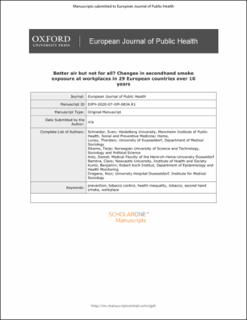| dc.contributor.author | Schneider, Sven | |
| dc.contributor.author | Lunau, Thorsten | |
| dc.contributor.author | Eikemo, Terje Andreas | |
| dc.contributor.author | Kotz, Daniel | |
| dc.contributor.author | Bambra, Clare | |
| dc.contributor.author | Kuntz, Benjamin | |
| dc.contributor.author | Dragano, Nico | |
| dc.date.accessioned | 2021-03-30T09:37:14Z | |
| dc.date.available | 2021-03-30T09:37:14Z | |
| dc.date.created | 2021-03-25T21:36:06Z | |
| dc.date.issued | 2021 | |
| dc.identifier.issn | 1101-1262 | |
| dc.identifier.uri | https://hdl.handle.net/11250/2736097 | |
| dc.description.abstract | Background
As the largest study of its kind to date, this article aims to describe the scope, trends over time, socio-demographic risk groups and the association with different progressive regulations relating to workplace second-hand smoke (SHS) exposure in 29 European countries during a period of high regulatory action.
Methods
Three waves of the European Working Conditions Surveys (2005, 2010 and 2015) were evaluated, including a total of 95 718 workers. The samples are representative for all employed residents of the 29 countries included. All interviews were conducted face-to-face at respondents’ homes (computer-assisted personal interviews). SHS exposure among the overall working population of 29 countries—including smokers—was examined. Workplace regimes were grouped corresponding to the sub-scale ‘workplace’ as used in the Tobacco Control Scale.
Results
Between 2005 and 2015, SHS exposure in the European countries declined from around 19.0% (95% CI 16.1–22.0) to 9.9% (8.3–11.5). High SHS-exposure was reported by workers with the lowest level of education [11.5% (9.7–13.2)], among high-skilled manual labourers [14.3% (12.1–16.4)] and among those without a standard employment contract [11.2% (9.3–13.1)]. The highest exposure was reported by workers in the food service industry [19.7% (16.8–22.6)]. Countries with less workplace-related smoking prevention regulations were found to have the highest overall levels of exposure.
Conclusion
This multinational series of cross-sectional surveys on the trends in passive smoking in the workplace have shown that countries with more comprehensive workplace smoking bans overall report lower levels of SHS exposure among their work force as compared with slow progressing countries. | en_US |
| dc.language.iso | eng | en_US |
| dc.publisher | Oxford University Press | en_US |
| dc.title | Better air but not for all? Changes in second-hand smoke exposure at workplaces in 29 European countries over 10 years | en_US |
| dc.type | Peer reviewed | en_US |
| dc.type | Journal article | en_US |
| dc.description.version | acceptedVersion | en_US |
| dc.source.journal | European Journal of Public Health | en_US |
| dc.identifier.doi | 10.1093/eurpub/ckab035 | |
| dc.identifier.cristin | 1901170 | |
| dc.description.localcode | Locked until 24.9.2921 due to copyright restrictions. This is a pre-copyedited, author-produced version of an article accepted for publication following peer review. The version of record is available online at: https://doi.org/10.1093/eurpub/ckab035 | en_US |
| cristin.ispublished | true | |
| cristin.fulltext | postprint | |
| cristin.qualitycode | 1 | |
